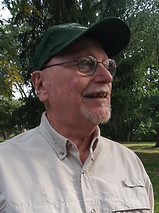
WHO WE ARE AND WHAT WE DO.
Our mission is simple: To be a force for Kirtland's Warbler conservation.
Our Board

Tom Cook, Acting Chair. Tom first saw the Kirtland's Warbler while serving as a Trustee of The Nature Conservancy in MIchigan. He is also a founding board member of the Friends of the Shiawassee River and co-chair of the Green and Blue Network of funders organized by the Council of Michigan Foundations. His day job is Executive Director of the Cook Family Foundation, a place-based philanthropy in Owosso Michigan.

Jerry Rucker, Treasurer. Jerry is one of the original KWA board members. He is an avid outdoorsman and conservationist. He is a member of the Huron Pines board of directors and a former chairman of the AuSable North Branch Area Foundation. He is retired from over forty years in the automotive industry.

James N. (Jim) Bull, Secretary. Jim teaches Biology and Environmental Science at two community colleges is a three-time past president of the Detroit Bird Alliance (formerly Detroit Audubon). His father co-coordinated the first Kirtland’s Warbler census in 1951 when he worked for the Michigan Conservation Dept. Jim co-chaired a joint campaign of Detroit and Michigan Audubon in 2004 to make the Kirtland’s our state bird. I love all nature, but the Kirtland’s is my favorite bird: beautiful to behold and with the most beautiful song.

Elizabeth Hengstebeck “Many years ago, I signed up as a volunteer to participate in the KW census. At that time, I really did not know much about the Kirtland's warbler or the efforts to save the bird from extinction. During that census, I heard the story of the KW's decline and its remarkable come back and met the people who were largely responsible for the success of this conservation effort. I was hooked! After that, I continued to participate in KW volunteer activities and was invited to join the KW Alliance board. My involvement in the ongoing conservation efforts for the KW gives me hope for the future of many other species who are endangered and at risk of extinction.”

William Volz believes conservation begins in our backyards. Literally, lots of wild things dine and frolic in his backyard. "I think of my personal life as a backyard where my time spent with the Kirtland's Warbler Alliance, the Oakland Audubon Society and Michigan Audubon has been time well spent."

Sydney Kuipers is an undergrad student at Northern Michigan University studying Ecology and Graphic Design. She learned about the KWA in high school after mentioning the Kirtland’s Warbler in an interview about one of her artworks. She hopes to pursue wildlife conservation and avian fieldwork in order to raise awareness for the KW and other bird species.

Ray Stocking is a self-taught bird enthusiast and dedicated conservationist. He is passionate about protecting wildlife and fostering environmental awareness. He has 15+ years of combined volunteer experience with Michigan Audubon and the Washtenaw Bird & Nature Alliance, where he served as Board Chair (MA) and President (WBNA). His deep appreciation for nature fuels his commitment to birdwatching, conservation advocacy, and educating others about the importance of preserving ecosystems.
ABOUT THE KIRTLAND'S WARBLER
The Kirtland's Warbler is the rarest songbird in North America with a story arc like no other no other animal.
1851—The ornithologist Charles Pease collects a bird on his father-in-law’s farm in northeastern Ohio. Even though he has a large collection of bird skins, Pease has no idea what species this odd little bird is. He gives it to his father-in-law, Jared P. Kirtland. Kirtland also has an extensive collection of bird skins but like Pease he is unable to identify this specimen. Conveniently, Spencer Baird, the secretary of the Smithsonian Institution is traveling through Cleveland. Baird takes the specimen back to the Smithsonian and compares it to the other birds in the collection. Baird concludes that this is a new species and starts to document it.
1852—Spencer Baird publishes a paper describing this new species in The Annals of the Lyceum of Natural History of New York. Baird names the bird after Kirtland, “a gentleman to whom, more than any one living, we are indebted for a knowledge of the Natural History of the Mississippi Valley.”
1879 - 1900. A Kirtland’s Warbler was first collected in The Bahamas on Andros in 1879 by C.B. Cory. As many as 28 specimens were collected on New Providence in 1884, when Nassau was a small city. During the 1879-1900 period relatively large numbers of Kirtland’s Warblers were found in The Bahamas compared to most of the 20th century.
1903—More than 50 years have passed and the Kirtland’s Warbler remains somewhat of a riddle to ornithologists. Even though ornithologists know much about most North America’s birds, they still know very little about the Kirtland’s Warbler. They are sure that the warbler spends its winters in the Bahamas because collectors are taking some from the archipelago every winter. But where does it nest? Michigan? Wisconsin? Minnesota? Farther north in Ontario near Hudson’s Bay?
In June, Earl Frothingham, a student at the University of Michigan, is on a fishing trip on the south branch of the Au Sable River when he hears a bird song that he cannot identify. Frothingham finds the bird and takes it as a specimen. He returns to Ann Arbor and gives the specimen to Norman Wood, a taxidermist at the university’s Museum of Natural History. Wood immediately identifies the bird as a Kirtland’s Warbler and makes plans to travel to the spot. On July 8, 1903, Wood discovers a Kirtland’s Warbler nest underneath the low-hanging branches of a jack pine tree. He digs up the nest and the land around it and takes it back to Ann Arbor with him for closer examination. Before returning to Ann Arbor, Wood discovers that local residents are already familiar with the Kirtland’s Warbler. They refer to it simply as “the jack pine bird.”
1912—As a result of a deadly wildfire that swept across the landscape and burned down the towns of Au Sable and Oscoda, the Michigan Public Domain Commission approves the purchase of 18 long-handled shovels to be given to employees to fight wildfires. The state now puts a priority on extinguishing wildfires to protect lives and property. That policy inadvertently leads to less and less breeding habitat for the Kirtland’s Warbler.
1923—In June, Nathan Leopold, a young genus from Chicago who studied under Wood at the University of Michigan, travels to the jack pine with three companions to research the Kirtland’s Warbler. He is the first to identify the parasitic Brown-headed Cowbird (Molothrus ater) as a threat to the Kirtland’s Warbler. Later that year he presents his findings at the annual meeting of the American Ornithologists’ Union and at age 19 he is lauded as the world’s foremost expert on the species.
1932—Lawrence Walkinshaw, an amateur ornithologist and dentist from Battle Creek, Michigan, becomes the first person band a Kirtland’s Warbler for research purposes. Not knowing of Walkinshaw’s efforts, four days later Josselyn Van Tyne, the curator of birds at the University of Michigan’s Museum of Natural History, bands a Kirtland’s Warbler for the same purpose. Once Walkinshaw learns of Van Tyne’s efforts, he steps aside to prevent competing efforts.
1951—Harold Mayfield, an amateur ornithologist and business executive from Toledo, Ohio, organizes the first Kirtland’s Warbler census. It is the first time that an effort is made to count the entire population of a single species. It’s decided the census will be held every 10 years.
1953—Van Tyne contributes a chapter on the Kirtland’s Warbler to Arthur Bent’s Life Histories North American Wood Warblers. It is considered to be the most authoritative knowledge gathered to date on the biology of the Kirtland’s Warbler.
1956—At the urging of Harold Mayfield, the Michigan Conservation Commission votes unanimously to set aside land to be managed as a Kirtland’s Warbler preserve.
1961—The second Kirtland’s Warbler census determines the Kirtland’s Warbler population has grown slightly over the past decade, going from 502 singing males from 432 singing males in 1951.
1966—Lawrence Walkinshaw starts a five-year effort to determine the impact of Brown-headed Cowbird parasitism on the Kirtland’s Warbler. His research leads biologists to conclude that if the cowbird’s impact is not abated the warbler would soon go extinct.
1971—The third Kirtland’s Warbler census is held and the results are shocking. Researchers find only 200 singing males. Assuming that every singing male has a mate, the total population is only 400 birds. Five months after the census, government biologists, university researchers, and Audubon members meet in Ann Arbor and form the Kirtland’s Warbler Advisory Committee. The new organization agrees to develop a long-term conservation plan that calls for a minimum of 1,000 breeding pairs, an extensive cowbird trapping program, and regular forest rotation to create new habitat. They also agree that the census should be held annually.
1973—The Endangered Species Act is approved by Congress and signed into law by President Richard Nixon. The Kirtland’s Warbler is among the first species given immediate protection. The advisory committee formed in 1971 is recognized by the U.S. Fish and Wildlife Service and given a new name—the Kirtland’s Warbler Recovery Team. Conservation of the Kirtland’s Warbler shifts from the State of Michigan, non-profit groups, and private individuals to the federal government.
1976—Michigan DNR foresters begin planting new jack pine plantations in an “opposing wave” pattern. Previous efforts at planting jack pines for Kirtland’s Warbler habitat put tightly packed jack pines in long rows. The goal of this new pattern is to have the landscape more closely resemble the randomness of a wildfire. The pattern allows for regularly spaced one-acre football shaped openings where wild blueberry, sweet fern and other low plants can grow. The warblers immediately show their preference for this pattern and abandon plots with the old planting scheme.
1980—As part of a plan to make new habitat for the Kirtland’s Warbler, U.S. Forest Service employees intentionally set fire to a small area south of Mio, Michigan. Strong winds soon cause the fire to burn out of control. The fire sweeps through the small community of Mack Lake, destroying most of the town’s structures. The fire eventually burns itself out, but only after one U.S. Forest Service is killed and more than 20,000 acres are charred. The fire is an awful tragedy, but it’s also an opportunity for biologists to gain new knowledge on how the jack pine habitat regenerates itself.
1987—The annual census counts only 167 singing males, which ties the all-time low. Researchers are worried but do not panic. Over the past two decades they have gained a much better grasp of the warbler’s nesting needs and understand that the current population is in a bottleneck because of limited habitat. They believe the population will quickly rebound as more habitat becomes available as a result of the Mack Lake Fire.
1988—The annual census counts 207 singing males. It is the start of a steady two-decade-long population increase largely because the birds have access to thousands of acres of newly created nesting habitat.
2001—The annual census counts 1,085 singing males. It is the first time that more than 1,000 singing males are recorded. In that same year, the Kirtland’s Warbler Research and Training Project, a joint project between the Bahamas National Trust, The Nature Conservancy, the International Program and International Institute of Tropical Forestry of the U.S. Forest Service, begins working in the Bahamas. The goal of the project is twofold. First, to gain better knowledge of the Kirtland’s Warbler’s winter habitat needs. Second, to help train Bahamian students as scientists and conservationists. The team works closely with two local partners, the Bahamas National Trust and The Nature Conservancy’s office in Nassau.
2007—A bird watcher discovers three singing male Kirtland’s Warbler in Adams County, Wisconsin. A day later he discovers a female Kirtland’s Warbler and soon he finds a nest with five eggs. It is the first evidence of the Kirtland’s Warbler nesting in that state. The Wisconsin DNR and the U.S. Fish and Wildlife Service begin searching for and monitoring Kirtland’s Warbler nests statewide. In 2017, 15 nests were discovered in the state.
2008—Canada approves a new endangered species law and immediately includes the Kirtland’s Warbler on its new Endangered Species List. Although a few singing males are recorded in eastern Ontario every summer, the most recent evidence of the species breeding in the province dates back to 2007.
2010—The winter ecology of the Kirtland’s Warbler is described in a paper published in the journal, The Condor, based on intensive studies on Eleuthera, Bahamas of over 200 color-banded birds and unbanded birds.
2012—For the first time, the annual census exceeds 2,000 singing males.
2014—Dr. Nathan Cooper of the Smithsonian Migratory Bird Center begins a research project to determine the migration routes of Kirtland’s Warblers by attaching tiny geolocaters to the backs of 60 male Kirtland’s Warblers. His research determines that the warblers use two different routes in their annual migration between the jack pine and the Bahamas.
2015—The Kirtland’s Warbler Recovery Team is dissolved and the Kirtland’s Warbler Conservation Team is formed. The focus of the team’s efforts shift away from ensuring the bird does not go extinct to ensuring the population stays at a healthy level. This continuing effort is necessary because the warbler is considered a “conservation reliant” species, which means it will require continuing human intervention to keep the population healthy.
2017—The U.S. Fish and Wildlife Service announced it would start the process of removing the Kirtland’s Warbler from the Endangered Species List.
2019—The Kirtland's Warbler is removed from the Endangered Species List.
2025—The 2025 census finds the population down about one-third from the 2021 census because the number of available acres of suitable nesting habitat has fallen by one third since the start of the decade. The Conservation Team renews efforts to ensure the Michigan DNR and the US Forest Service meet their goal of creating 3,xxx acres of new nesting habitat for the warbler annually.
Our Partners
Our partners include:
Huron Pines
Michigan Audubon Society
Michigan Department of Natural Resources
U.S. Forest Service
U.S. Fish and Wildlife Service
American Bird Conservancy
Michigan Nature Association